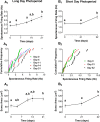Steroid hormones act transsynaptically within the forebrain to regulate neuronal phenotype and song stereotypy
- PMID: 17978046
- PMCID: PMC6673362
- DOI: 10.1523/JNEUROSCI.3289-07.2007
Steroid hormones act transsynaptically within the forebrain to regulate neuronal phenotype and song stereotypy
Abstract
Steroid sex hormones induce dramatic seasonal changes in reproductive related behaviors and their underlying neural substrates in seasonally breeding vertebrates. For example, in adult white-crowned sparrows, increased Spring photoperiod raises circulating testosterone, causing morphological and electrophysiological changes in song-control nuclei, which modify song behavior for the breeding season. We investigated how photoperiod and steroid hormones induce these changes in morphology, electrophysiology, and behavior. Neurons in a song premotor nucleus, the robust nucleus of the arcopallium (RA), show increased intrinsic spontaneous firing rate and soma size when birds are in breeding condition. Using combinations of systemic and unilateral local intracerebral hormonal manipulations, we show that long-day photoperiod accelerates the effects of systemic testosterone on RA neurons via the estradiol-synthesizing enzyme aromatase (CYP19A1); these changes require inputs from the afferent song control nucleus HVC (used as a proper name) and steroid receptor activation within HVC; local coactivation of androgen and estrogen receptors (ARs and ERs, respectively) within HVC, but not RA, is sufficient to cause neuronal changes in RA; activation of ARs in RA is also permissive. Using bilateral local intracerebral hormone-receptor blockade, we found that ARs and ERs in the song-control nucleus HVC mediate systemic testosterone-induced changes in song stereotypy but not rate. This novel transsynaptic effect of gonadal steroids on activity and morphology of RA neurons is part of a concerted change in key premotor nuclei, enabling stereotyped song.
Figures








Similar articles
-
Seasonal-like growth and regression of the avian song control system: neural and behavioral plasticity in adult male Gambel's white-crowned sparrows.Gen Comp Endocrinol. 2008 Jul;157(3):259-65. doi: 10.1016/j.ygcen.2008.03.014. Epub 2008 Mar 25. Gen Comp Endocrinol. 2008. PMID: 18457836 Free PMC article. Review.
-
Plastic and stable electrophysiological properties of adult avian forebrain song-control neurons across changing breeding conditions.J Neurosci. 2009 May 20;29(20):6558-67. doi: 10.1523/JNEUROSCI.5571-08.2009. J Neurosci. 2009. PMID: 19458226 Free PMC article.
-
Brain-Derived Neurotrophic Factor Has a Transsynaptic Trophic Effect on Neural Activity in an Adult Forebrain Circuit.J Neurosci. 2020 Feb 5;40(6):1226-1231. doi: 10.1523/JNEUROSCI.2375-19.2019. Epub 2019 Dec 19. J Neurosci. 2020. PMID: 31857358 Free PMC article.
-
Seasonal-like plasticity of spontaneous firing rate in a songbird pre-motor nucleus.J Neurobiol. 2005 Aug;64(2):181-91. doi: 10.1002/neu.20145. J Neurobiol. 2005. PMID: 15818555
-
Seasonal plasticity in the song control system: multiple brain sites of steroid hormone action and the importance of variation in song behavior.Ann N Y Acad Sci. 2004 Jun;1016:586-610. doi: 10.1196/annals.1298.043. Ann N Y Acad Sci. 2004. PMID: 15313796 Review.
Cited by
-
Changing neuroestrogens within the auditory forebrain rapidly transform stimulus selectivity in a downstream sensorimotor nucleus.J Neurosci. 2012 Jun 13;32(24):8231-41. doi: 10.1523/JNEUROSCI.1114-12.2012. J Neurosci. 2012. PMID: 22699904 Free PMC article.
-
Neuroestrogen synthesis modifies neural representations of learned song without altering vocal imitation in developing songbirds.Sci Rep. 2020 Feb 27;10(1):3602. doi: 10.1038/s41598-020-60329-3. Sci Rep. 2020. PMID: 32108169 Free PMC article.
-
Seasonal-like growth and regression of the avian song control system: neural and behavioral plasticity in adult male Gambel's white-crowned sparrows.Gen Comp Endocrinol. 2008 Jul;157(3):259-65. doi: 10.1016/j.ygcen.2008.03.014. Epub 2008 Mar 25. Gen Comp Endocrinol. 2008. PMID: 18457836 Free PMC article. Review.
-
Forebrain steroid levels fluctuate rapidly during social interactions.Nat Neurosci. 2008 Nov;11(11):1327-34. doi: 10.1038/nn.2200. Epub 2008 Sep 28. Nat Neurosci. 2008. PMID: 18820691 Free PMC article.
-
Plasticity in singing effort and its relationship with monoamine metabolism in the songbird telencephalon.Dev Neurobiol. 2010 Jan;70(1):41-57. doi: 10.1002/dneu.20752. Dev Neurobiol. 2010. PMID: 19899137 Free PMC article.
References
-
- Adret P, Margoliash D. Metabolic and neural activity in the song system nucleus robustus archistriatalis: effect of age and gender. J Comp Neurol. 2002;454:409–423. - PubMed
-
- Aguado F, Carmona MA, Pozas E, Aguiló A, Martínez-Guijarro FJ, Alcantara S, Borrell V, Yuste R, Ibañez CF, Soriano E. BDNF regulates spontaneous correlated activity at early developmental stages by increasing synaptogenesis and expression of the K+/Cl- co-transporter KCC2. Development. 2003;130:1267–1280. - PubMed
-
- Arnold AP, Nottebohm F, Pfaff DW. Hormone concentrating cells in vocal control and other areas of the brain of the zebra finch (Poephila guttata) J Comp Neurol. 1976;165:487–511. - PubMed
Publication types
MeSH terms
Substances
Grants and funding
LinkOut - more resources
Full Text Sources
